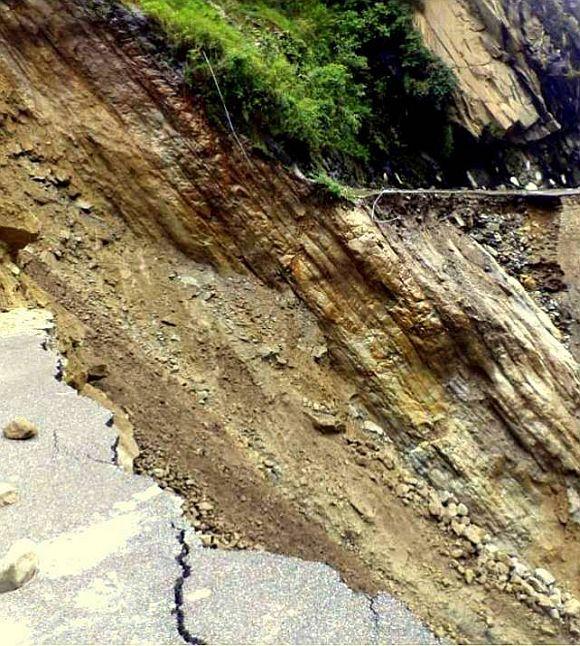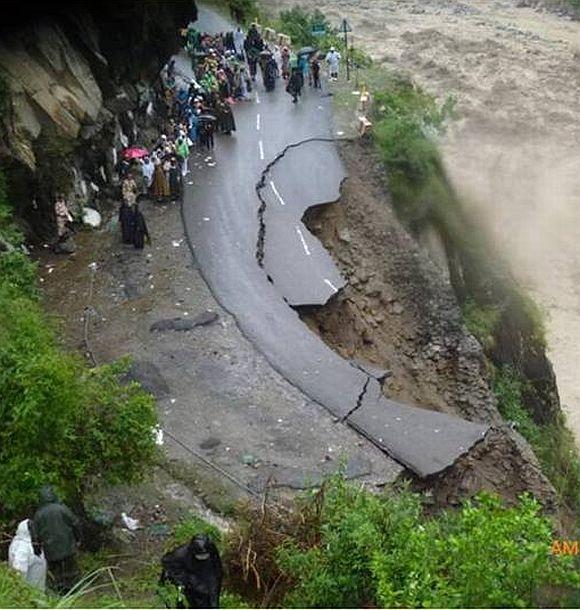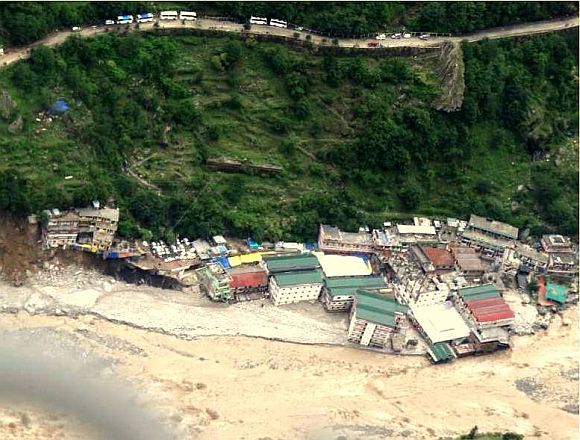
Expansion of hydel projects, roads and tourism is making the Himalaya in Uttarakhand crumble. Jyotsna Singh reports
Uttarakhand and Himachal Pradesh, two hill states in the Himalayan range, are so far the worst hit by the extreme rains that struck northern India in the wake of monsoons that set in early this year.
Media reports say nearly 100 persons have died in Uttarakhand, and an estimated 60,000 pilgrims are stranded.
Heavy rainfall has wreaked havoc on the region because of the fragile nature of the Himalayan range and poor soil stability in its steep slopes.
But it is man-made factors that have compounded the scale of the disaster.

Unabated expansion of hydro-power projects and construction of roads to accommodate ever-increasing tourism, especially religious tourism, are also major causes for the unprecedented scale of devastation, say experts.
"The valleys of the Yamuna, the Ganga and the Alaknanda witness heavy traffic of tourists. For this, the government has to construct new roads and widen the existing ones," says Maharaj Pandit, professor with the Department of Environmental Sciences in Delhi University.
He says that a study should be conducted to assess the carrying capacity of the Himalaya and development should be planned accordingly.
...

Roads destabilising mountains
"A new (mountain) range like the Himalaya will remain steady if not tampered with much. But the huge expansion of roads and transport is bringing the mountains in Uttarakhand down," says Pandit.
Road, he says, is a major destabilising factor for a mountain and it is a new phenomenon for the Himalaya.
Pandit, who is in Uttarakhand for a research project, recounts an observation.
"I was sitting at the Prayag bridge for tea and started counting the number of buses crossing it. Within seven to eight minutes, 117 buses crossed," he says.
Data with the Uttarakhand State Transport Department confirms this.
In 2005-06, 83,000-odd vehicles were registered in the state. The figure rose to nearly 180,000 in 2012-13.
Out of this, proportion of cars, jeeps and taxis, which are the most preferred means of transport for tourists landing in the state, increased the most.
...

In 2005-06, 4,000 such vehicles were registered, which jumped to 40,000 in 2012-13 -- a whopping 1000 per cent increase. It is an established fact that there is a straight co-relation between tourism increase and higher incidence of landslides.
Pandit says that rampant construction, be it of roads, or dams, has led to land use change and the cumulative effect is getting reflected in the extent of damage rains have caused.
Landslides more frequent now
“Our mountains were never so fragile. But these heavy machines plying everyday on the kutcha roads have weakened it, and now we suffer landslides more often,” says Harish Rawat, a BSc student in Uttarakhand’s Bhatwari region that suffered a major landslide in 2010.
Rawat lost his home to the landslide when a major part of the main market and 28 shops were wiped out by the landslide. About 25 other houses were destroyed completely.
...

Another local resident, Ram Prasad Tomar, a driver by profession in Uttarkashi town, says it is road cutting that has made the mountains so weak.
He says the way mountains are cut to make roads has rendered the mountains unstable. “Road contractors, who come from outside, do not understand the mountains. Most of the expressways that are being constructed now are tangled in legal cases. After cutting of mountains, landslides continue for up to four years, and contractors go bankrupt clearing the debris,” he says.
Environment engineer and Ganga crusader, G D Agarwal, says that construction along the Ganga has certainly cost a lot more if one includes the cost of damage to environment. People have completely destroyed the ecology of the mountains.
“We see more landslides nowadays because of unplanned development in the hills,” he says.
Experts say promotion of the state as a tourist destination is coming in way of sustainable development.
Click on MORE to see related PHOTO feature...